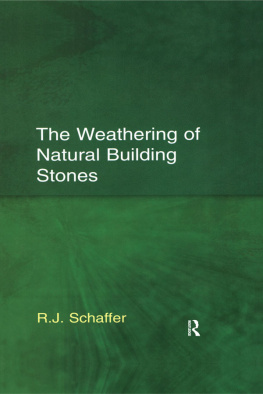Schaffer - The Weathering of Natural Building Stones
Here you can read online Schaffer - The Weathering of Natural Building Stones full text of the book (entire story) in english for free. Download pdf and epub, get meaning, cover and reviews about this ebook. year: 2016, publisher: Routledge;Taylor and Francis, genre: Science. Description of the work, (preface) as well as reviews are available. Best literature library LitArk.com created for fans of good reading and offers a wide selection of genres:
Romance novel
Science fiction
Adventure
Detective
Science
History
Home and family
Prose
Art
Politics
Computer
Non-fiction
Religion
Business
Children
Humor
Choose a favorite category and find really read worthwhile books. Enjoy immersion in the world of imagination, feel the emotions of the characters or learn something new for yourself, make an fascinating discovery.
The Weathering of Natural Building Stones: summary, description and annotation
We offer to read an annotation, description, summary or preface (depends on what the author of the book "The Weathering of Natural Building Stones" wrote himself). If you haven't found the necessary information about the book — write in the comments, we will try to find it.
The Weathering of Natural Building Stones — read online for free the complete book (whole text) full work
Below is the text of the book, divided by pages. System saving the place of the last page read, allows you to conveniently read the book "The Weathering of Natural Building Stones" online for free, without having to search again every time where you left off. Put a bookmark, and you can go to the page where you finished reading at any time.
Font size:
Interval:
Bookmark:
THE WEATHERING OF
NATURAL BUILDING
STONES
R.J. Schaffer
With an introduction by Dr Tim Yates

First published in 1932 by for the Department of Scientific and
Industrial Research by HM Stationery Office, London
Published by Donhead Publishing Ltd 2004
Published 2015 by Routledge
2 Park Square, Milton Park, Abingdon, Oxon 0X14 4RN
711 Third Avenue, New York, NY 10017, USA
Routledge is an imprint of the Taylor & Francis Group, an informa business
BRE 2004
All rights reserved. No part of this book may be reprinted or reproduced or utilised in any form or by any electronic, mechanical, or other means, now known or hereafter invented, including photocopying and recording, or in any information storage or retrieval system, without permission in writing from the publishers.
Product or corporate names may be trademarks or registered trademarks, and are used only for identification and explanation without intent to infringe.
ISBN 13: 978-1-873394-69-4 (hbk)
A CIP catalogue for this, book is available from the British Library
The background to the publication of R.J. Schaffers famous report on The Weathering of Natural Building Stones is very well summarized in F.M. Leas book Science and Building published in 1971. Here we learn that in 1920 the Imperial War Graves Commission (now the Commonwealth War Graves Commission) and the authorities of Westminster Abbey sought advice from the Building Research Board on the weathering and preservation of natural building stone. At the same time there was pressure from both the Royal Institute of British Architects and the Society of Architects for work in these fields. In 1923 the Advisory Committee of the Department of Scientific and Industrial Research (DSIR) commented:
The decay to which stonework is subject, especially under the actions of impurities in the atmosphere of our large towns, is a matter of common observation and the question has become one of general economic importance It constitutes a special problem which has engaged the attention of many investigators for a considerable time without, however, finding any generally satisfactory solution.
It was against this background that R.J. Schaffer began his work at the Building Research Station at Garston in early 1925. Over the next six years Schaffer considered over 250 books and papers on the subject of universally as Schaffer.
At the same time Schaffer visited and studied many quarries in the UK carrying out much of the work with F.H. Edmunds of the British Geological Survey. In particular, they undertook extensive surveys of the Jurassic Portland limestone quarries and Permo-triassic Magnesian limestone quarries in north-east England. The archive of site notes, photographs, samples and analyses from this work is at BRE and is still in regular use. Schaffer was also responsible for the preparation and examination of more than 6000 petrographic thin sections which are now known at BRE as the Hurst Collection after the technician who carried out the work.
Schaffers report is still very relevant and is a valuable reference work. The sections on the causes of weathering are still correct even phenomena has now swung away from acidic pollution and natural processes. The only part where thinking is differs significantly today is processes. The only part where thinking is differs significantly today is the section on Preventative and Remedial Measures where current practice favours less aggressive cleaning methods and less harsh repair materials.
The last paragraph in the Report still seems particularly relevant to much of our work related to the service life of stone. In this paragraph Schaffer wrote:
The fact is, that the life of a building stone is an indeterminate quantity, since its useful life may be regarded as completed when the material begins to look unsightly, or when its fails to carry the load imposed on it. The former depends on the aesthetic sense of the observer, the latter on innumerable structural factor. Nevertheless, the difficulty of interpreting the tests in terms of years cannot be considered to detract from the value of the laboratory examination.
Schaffer has remained in print for most the last 70 years which is in itself a testimony to the continuing relevance of the findings, and so it is a great pleasure to write an introduction to this latest edition.
Tim Yates
February 2004
Tim Yates B.Tech(Hons), Ph.D(London)
Tim Yates spent four years as a field archaeologist before reading Archaeological Sciences at Bradford University. After three years at University College London researching the analysis and geochemistry of Holocene carbonate sediments he joined BRE in 1986 as a Higher Scientific Officer to compile and edit the report of the Building Effects Review Group on the effect of acid deposition on buildings and building materials.
After BRE was privatized in 1997 he took on responsibility for the team researching heritage buildings, stone, and mortar. This team is currently carrying out research on the durability and testing of natural building stone. Much of this research relates to the development of European standards for the testing and specification of natural stone for cladding, masonry and flooring.
The Team is also responsible for undertaking consultancy projects on natural stone and in the last 10 years more than 500 projects in the US, Canada, Croatia, Bosnia, Israel, Abu Dhabi, Hong Kong and Singapore as well as the UK and Ireland have been completed; many of these relate to the deterioration of natural stone or to the selection and testing of stone for construction.

DEPARTMENT OF SCIENTIFIC AND INDUSTRIAL RESEARCH
BUILDING RESEARCH
SPECIAL REPORT No. 18
THE WEATHERING OF
NATURAL BUILDING STONES
BY
R. J. SCHAFFER, B.A., B.Sc. (Oxon)
Crown Copyright Reserved
LONDON :
PUBLISHED BY HIS MAJESTYS STATIONERY OFFICE
1932
47418
R J Schaffers Weathering of natural building stones was first published in 1932 and has been out of print for some years, following a decision to revise it. For a number of reasons it has not been possible to effect a full revision. Because of the continuing demand for this book which is still the most authoritative and comprehensive work in its field, it has been decided to reprint with minimal changes.
This reprint is a facsimile of the first edition in all but one respect: a new Appendix II has been substituted and contains up-to-date information on the cleaning of external surfaces of buildings and colourless treatments for masonry. This new material is based on recent BRS Digests.
T HE problem of the weathering of natural building stones is of considerable practical interest both to the building industry and to the general public. Information thereon is somewhat widely scattered, and the time seems ripe to survey the general problem, and to link with it the results of the investigations which have been carried out by the Building Research Station during the past five or six years, and which have been reported from time to time in the Annual Reports of the Building Research Board.
Scientific investigation to be effective, must, if possible, be carried to some finality and when, as in stone decay, the problems involve fundamental research, not only into the physics and chemistry of materials but also into accidental causes such as smoke pollution, then it is only to be expected that much time and expenditure will be required. One of the difficulties in the past has been that the work has been undertaken by individual investigators working alone with inadequate financial support. An inquiry such as this can only be undertaken by a Government department or by a firm with considerable financial resources at its disposal. Since the return, however large to the community, will be relatively small to the individual, a Government department is practically the only body that can deal with it and make the information obtained available to all those interested in the subject.
Font size:
Interval:
Bookmark:
Similar books «The Weathering of Natural Building Stones»
Look at similar books to The Weathering of Natural Building Stones. We have selected literature similar in name and meaning in the hope of providing readers with more options to find new, interesting, not yet read works.
Discussion, reviews of the book The Weathering of Natural Building Stones and just readers' own opinions. Leave your comments, write what you think about the work, its meaning or the main characters. Specify what exactly you liked and what you didn't like, and why you think so.












